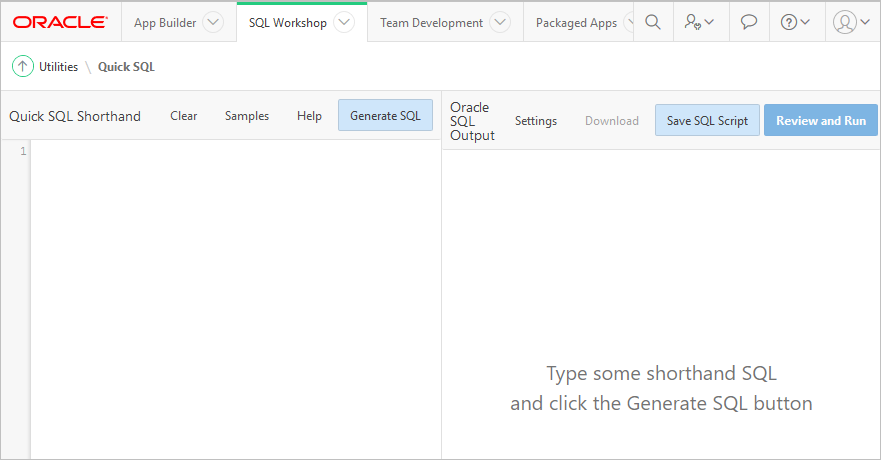Oracle Auto Generate Primary Key
Jan 07, 2020 2 Ways to Create Auto Increment Column in Oracle (primary key) Create Auto increment column in oracle By using IDENTITY Column example: ALWAYS AS IDENTITY Example: We are using ALWAYS to force the use of IDENTITY. BY DEFAULT AS IDENTITY Example: Create IDENTITY column with BY DEFAULT option to. How to get primary key value (auto-generated keys) from inserted queries using JDBC? Description: When we are inserting a record into the database table and the primary key is an auto-increment or auto-generated key, then the insert query will generate it dynamically. Sep 21, 2010 Hi all, I want to automatically populate a primary key column in the target data store. I have done the following things to implement this. Create a sequence in the DB 2. Create a refresh variable named 'abc' which has the following query: select MYSEQUENCE.nextval from dual 3.in the mapping of the PK column, im using #abc The query is working fine in SQL but in. 18.5.1 Partitioning Keys, Primary Keys, and Unique Keys This section discusses the relationship of partitioning keys with primary keys and unique keys. Pre install microsoft office 365 product key generator for microsoft office 2016. The rule governing this relationship can be expressed as follows: All columns used in the partitioning expression for a partitioned table must be part of every unique key that the table may have.

How to create id with AUTOINCREMENT on Oracle? Ask Question. It does not generate an incrementing numeric value. ( x number primary key ); create sequence FOO. May 25, 2016 4. Re: Auto Generated Primary Key Paulzip May 25, 2016 9:37 AM (in response to Sachith Perera) Sequences are the best way. Oracle introduced Identities (a sequence linked to a column), but these are in 12c only and are implemented using. For MyISAM tables, you can specify AUTOINCREMENT on a secondary column in a multiple-column index. In this case, the generated value for the AUTOINCREMENT column is calculated as MAX(autoincrementcolumn) + 1 WHERE prefix=given-prefix. This is useful when you want to put data into ordered groups.
Similar to MySQL, PostgreSQL, Oracle, and many other relational databases, SQL Server is best utilized when assigning unique primary keys to most database tables.
The advantages to using numeric, auto incremented primary keys are numerous, but the most impactful benefits are faster speed when performing queries and data-independence when searching through thousands of records which might contain frequently altered data elsewhere in the table. Sims 4 name generator. With a consistent and unique numeric identifier, applications can take advantage of these faster and more reliable queries.
Basic Table Creation
Once connected to your SQL Server, you’d normally start by CREATING a new table that contains the the field you wish to use as your incremented primary key. For our example, we’ll stick with the tried and true id field:
The problem here is, we have no way of controlling our id field. When a new record is inserted, we not only must manually enter a value for id, but we have to perform a query ahead of time to attempt to verify that id value doesn’t already exist (a near-impossibility when dealing with many simultaneous connections).
Using Identity and Primary Key Constraints
The solution turns out to be using two constraint options provided by SQL Server.
The first is PRIMARY KEY, which as the name suggests, forces the specified column to behave as a completely unique index for the table, allowing for rapid searching and queries.
While SQL Server only allows one PRIMARY KEY constraint assigned to a single table, that PRIMARY KEY can be defined for more than one column. In a multi-column scenario, individual columns can contain duplicate, non-unique values, but the PRIMARY KEY constraint ensures that every combination of constrained values will in fact be unique relative to every other combination.

The second piece of the puzzle is the IDENTITY constraint, which informs SQL Server to auto increment the numeric value within the specified column anytime a new record is INSERTED. While IDENTITYcan accept two arguments of the numeric seed where the values will begin from as well as the increment, these values are typically not specified with the IDENTITY constraint and instead are left as defaults (both default to 1).
Oracle Auto Increment Primary Key 12c
With this new knowledge at our fingertips, we can rewrite our previous CREATE TABLE statement by adding our two new constraints.
Oracle Auto Generate Primary Keys
That’s all there is to it. Now the id column of our books table will be automatically incremented upon every INSERT and the id field is guaranteed to be a unique value as well.